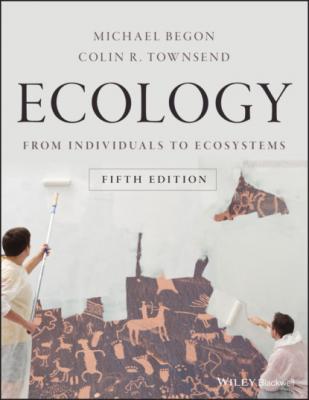Ecology. Michael Begon
Читать онлайн.| Название | Ecology |
|---|---|
| Автор произведения | Michael Begon |
| Жанр | Биология |
| Серия | |
| Издательство | Биология |
| Год выпуска | 0 |
| isbn | 9781119279310 |
Figure 3.24 Effects of CO2enhancement on plant protein concentrations with potentially harmful consequences. (a) The ratios of grain protein concentration (left) and the total protein‐nitrogen harvested from wheat, Triticum aestivum (right) in a free air CO2 enrichment facilities (FACE) experiment comparing enhanced to ambient CO2 concentrations at low and high soil nitrogen levels. Bars are SEs. (b) The proportion of nitrogen in wheat leaves that was nitrate over the course of this same experiment, which was consistently higher at elevated than ambient CO2 concentrations (P < 0.0001), indicative of lower nitrate assimilation at elevated concentrations. Bars are SEs. (c) The protein content of goldenrod (Solidago spp.) pollen in relation to atmospheric CO2 concentration from museum collections from 1842 to 1998 (left, r2 = 0.81, P < 0.001) and from a FACE‐type experiment generating a CO2 gradient (right, r2 = 0.88, P < 0.01). Bars are SEs.
Source: (a) After Kimball et al. (2001). (b) After Bloom et al. (2014). (c) After Ziska et al. (2016).
A second example looked at the effect of increased CO2 concentrations on the protein content of pollen from goldenrod plants, Solidago spp., in the USA, widely acknowledged by apiarists to be essential for the health and winter survival of both native bees (e.g. Bombus spp.) and honey bees (Apis melifera). Data both from historical records of pollen collected as CO2 levels have risen, and from experiments that used a FACE‐like facility to establish a CO2 gradient, showed that the protein content of the pollen was reduced substantially by increases in CO2 concentrations (Figure 3.24c). These reductions could have serious effects on bee numbers, on pollination rates and hence on plant productivity, but the generality of these effects, the abilities of bees to mitigate them through changes in their own behaviour, and indeed the extent of the harm done to bees all remain to be determined. Examples such as these, therefore, emphasise both how profound the potential implications of CO2 increases may be, in their own right, for future food security, and how difficult these implications can be to predict.
3.5 Mineral nutrients
macronutrients and trace elements
It takes more than light, CO2 and water to make a plant. Mineral resources are also needed and these must be obtained from the soil or, in the case of aquatic plants, from the surrounding water. These include macronutrients (i.e. those needed in relatively large amounts) – nitrogen (N), phosphorus (P), sulphur (S), potassium (K), calcium (Ca), magnesium (Mg) and iron (Fe) – and a series of trace elements, for example, manganese (Mn), zinc (Zn), copper (Cu), boron (B) and molybdenum (Mo) (Figure 3.25). Many of these elements are also essential to animals, although it is more common for animals to obtain them in organic form in their food than as inorganic chemicals. Some plant groups have special requirements. For example, aluminium is a necessary nutrient for some ferns, silicon for diatoms, and selenium for certain planktonic algae.
Figure 3.25 Periodic table of the elements showing those that are essential resources in the life of selected organisms.
Green plants do not obtain their mineral resources as a single package. Each element enters the plant independently as an ion or a molecule, and each has its own characteristic properties of absorption in the soil and of diffusion, which affect its accessibility to the plant even before any selective processes of uptake occur at the root membranes. All green plants require all of the ‘essential’ elements listed in Figure 3.25, although not in the same proportion, and there are some quite striking differences between the mineral compositions of plant tissues of different species and between the different parts of a single plant (Figure 3.26).
Figure 3.26 The mineral compositions of different plants and plant parts are very different. (a) The relative concentration of various minerals in whole plants of four species in the Brookhaven Forest, New York. (b) The relative concentration of various minerals in different tissues of the white oak (Quercus alba) in the Brookhaven Forest. Note that the differences between species are much less than between the parts of a single species.
Source: After Woodwell et al. (1975).
foraging for nutrients
There are strong interactions between water and nutrients as resources for plant growth. Roots will not grow freely into soil zones that lack available water, and so nutrients in these zones will not be exploited. Plants deprived of essential minerals make less growth and may then fail to reach volumes of soil that contain available water. There are similar interactions between mineral resources. A plant starved of nitrogen makes poor root growth and so may fail to ‘forage’ in areas that contain available phosphate or indeed contain more nitrogen. Again, plants may make both strategic and tactical responses to heterogeneities in nutrient availability (Hodge, 2004).
nitrogen
Nitrogen is the element that organisms require in the greatest amounts after carbon, hydrogen and oxygen. It is no surprise therefore that nitrogen availability often limits overall productivity in an ecosystem. Higher plants acquire nitrogen through their roots in inorganic form – as ammonium and nitrate salts – and in organic forms as urea, peptides and amino acids. This is true, too, of microorganisms, but they are best adapted to use the organic sources, followed by ammonium and then nitrate. Phytoplankton, fungi, cyanobacteria and bacteria, therefore, usually only assimilate nitrate in the absence of organic nitrogen
